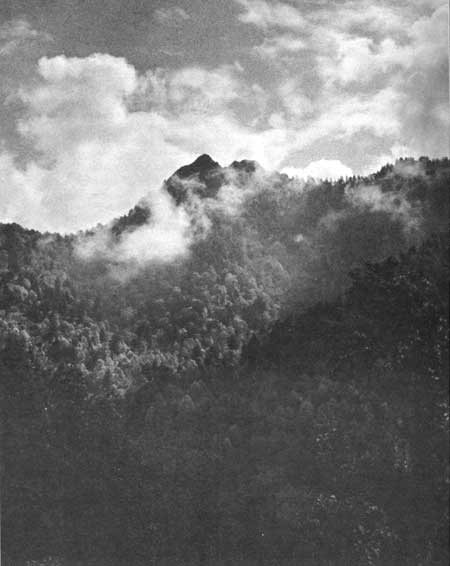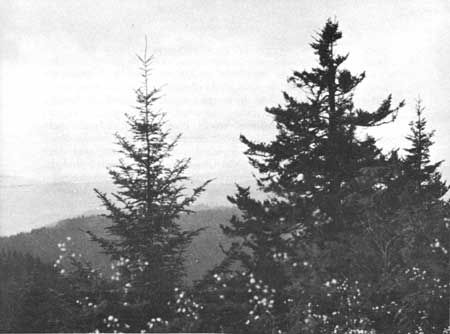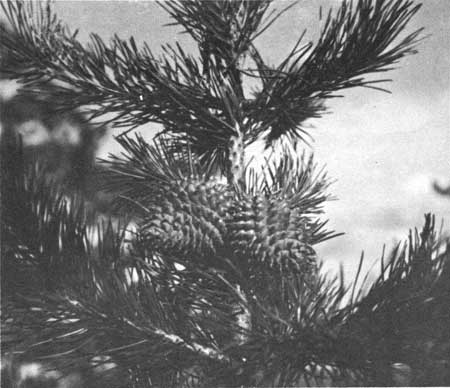|
GREAT SMOKY MOUNTAINS National Park |
 |
Land of the Great Forests
The forests of the Great Smokies are notable for the large variety of native trees. How many kinds are there? It would be difficult to find two botanists who would agree on the answer. The difference between a shrub and a tree is, at best, rather vague—somewhat like the difference between a pond and a lake, or a hill and a mountain. Where are we to draw the line? A generally accepted definition is that a tree is a woody plant with a well-defined stem and crown, has a diameter of 2 inches or more, and attains a height of at least 8 feet. This will include a number of plants which ordinarily are shrublike but which, on occasion, become arborescent, or treelike; examples are mountain-laurel, witch-hazel, staghorn sumac, the three kinds of native plums, mountain winterberry, the various hawthorns, three species of Viburnum, mountain stewartia, the tree sparkleberry, alder, devils-walkingstick, and alternate-leaf dogwood. Counting these, there are more than 100 kinds of native trees in the area.
 The Chimney Tops as seen from the transmountain road. This most photographed landmark towers above the head of the Sugarlands Valley. Many species of trees make up the dense forests, here and throughout the lower and middle altitudes. Courtesy, Tennessee Conservation Department. |
Some of the trees, such as the red spruce and Fraser fir, are found only in the colder and more moist situations at high altitudes; others, such as scarlet and black oaks and most of the pines, grow only on dry exposed slopes at low and middle elevations; still others, notably yellow buckeye, basswood, and mountain silverbell, are the "key" species in protected valleys below the usual limits of spruce and fir. A few trees, such as the Allegheny serviceberry, range over a wide variety of habitats, but all are limited by combinations of such factors as temperature and length of growing season (these two being correlated with altitude) and by moisture and depth of soil (these being correlated with topographic position).
 Along one of the trails in the park, a hiker admires the straight trunk of a big yellow-poplar. Eastern hemlocks are in the foreground. Courtesy, Tennessee Conservation Department. |
COVE HARDWOOD FORESTS
These forests occur in sheltered situations, at low and middle altitudes (below 4,500 feet) where there is a considerable depth of soil. Dominant trees are yellow buckeye, basswood, yellow-poplar, mountain silverbell, eastern hemlock, white ash, sugar maple, yellow birch, American beech, black cherry, northern red oak, cucumber-tree, and, in former years, American chestnut. All these grow to record or near-record proportions in the park. Wherever a number of these are found together, and where the ropelike strands of the common Dutchmanspipe make good growth, we find ourselves in the splendid big-tree groves of the Great Smokies. It is largely due to the occurrence of various unspoiled stands of these cove hardwood forests, along with the stands of Canadian-zone spruce and fir at the higher elevations, that Great Smoky Mountains National Park deserves its reputation as an outstanding wilderness stronghold.
It may be difficult for some of us to realize that the cucumber-tree grows to be greater than 18 feet in circumference, yet such a tree stands in the Greenbrier area of the park. A yellow buckeye is almost 16 feet in circumference, a yellow birch over 14 feet a mountain silverbell almost 12 feet, a sugar maple over 13 feet, and a yellow-poplar over 24 feet—these are circumference measurements taken at 4-1/2 feet from the ground. All are cove hardwood species in the park.
Fraser magnolia, one of the many smaller trees in these forests, also reaches record proportions here; specimens are known to attain a height of over 75 feet and a trunk diameter of more than 2 feet. A number of shrubs, one of the most prevalent of which is the rosebay rhododendron, and a long list of spring-blooming herbs are to be found in the cove hardwood forests.
HEMLOCK FORESTS
The eastern hemlock is a common tree along streams and lower slopes up to an altitude of 3,500 to 4,000 feet. It also occurs on exposed slopes and ridges at middle altitudes and up to almost 5,000 feet, where it stops rather abruptly, there being practically no hemlocks above 5,500 feet. Associated with the hemlock are such trees as the red and sugar maples, American beech, yellow and sweet birches, black and pin cherries, American holly, yellow-poplar, and mountain silverbell. Both the rosebay and catawba rhododendrons are common shrubs in hemlock forests, the former being an abundant streamside understory while the latter occurs in heath "balds" on the higher exposed ridges. Drooping leucothoe, smooth hydrangea, scarlet elder, thornless blackberry, mountain-laurel, and hobblebush are the other shrubs one might expect here. The variety of spring-blooming herbs is not nearly as extensive as in the cove hardwood forests.
 Naturalists measure the largest known eastern hemlock, which has a trunk circumference of 19 feet, 10 inches. Courtesy, Dr. William Hutson. |
NORTHERN HARDWOOD FORESTS
These forests, largely dominated by yellow birch and American beech, occur mostly above 4,500 feet. Often they are almost surrounded by red spruce and Fraser fir. Such trees as sugar maple, black cherry, and eastern hemlock—all a part of the northern hardwood forests—reach their uppermost limits at, or near, the 5,000-foot elevation. Red maple, striped maple, American beech, yellow buckeye, and Allegheny serviceberry drop out before, or at, the 6,000-foot elevation. Yellow birch, pin cherry, and mountain maple may reach the summits of the higher mountains where, normally, spruce and fir are dominant. The variety of shrubs in these forests is limited mostly to smooth hydrangea, drooping leucothoe, catawba and rosebay rhododendrons, thornless blackberry, and hobblebush. Herbaceous plants, especially those which bloom in the spring, are of considerable variety; some of the most abundant of these include the Virginia springbeauty, common fawnlily, creeping bluet, American woodsorrel, fringed phacelia, great starwort, trilliums, violets, crinkleroot, and yellow beadlily.
SPRUCE-FIR FORESTS
Along the high State-line ridge which runs the length of the park, a forest of spruce and fir extends in an almost unbroken stand from the western slope of Clingmans Dome to near Cosby Knob, close to the park's northeastern corner—an air-line distance of approximately 25 miles. Only in the vicinity of Charlies Bunion, swept by the great fire of 1925, is there an appreciable break in the evergreen chain. On the Tennessee side of the park, the finest growth is on Mount Le Conte, third-highest peak in the Smokies; on the North Carolina side, the area southward from Mount Guyot (second-highest peak), between Hughes Ridge and Balsam Mountain, contains the most extensive spruce-fir stand. Above the 6,000-foot altitude, the only trees occasionally associated with the red spruce and Fraser fir are yellow birch, pin cherry, American mountain-ash, and mountain maple.
 Fraser fir and red spruce (right). These high-altitude trees in the Great Smoky Mountains are symbolic of the Canadian zone. |
So dense does the growth of trees become that shrubs and other plants may be practically absent over wide areas. However, in places the following shrubs may be found: catawba and Carolina rhododendrons, southern bush-honeysuckle, Allegheny menziesia, scarlet elder, dingleberry, thornless blackberry, roundleaf gooseberry, hobblebush, witherod, and Blueridge blueberry. Ferns prevailing at these high altitudes include the toothed woodfern and hayscented, lady, and common polypody ferns. Most conspicuous of the spring-blooming herbs include creeping bluet, Virginia springbeauty, American woodsorrel, pallid violet, painted trillium, erect trillium (white and purple forms) and yellow beadlily; the summer-blooming herbs that you are most likely to see include acuminate aster, white wood aster, cluster goldenrod, pink turtlehead, Indianpipe, and Rugel's groundsel.
CLOSED OAK FORESTS
On intermediate to dry slopes, at low and middle altitudes, the forests are dominated by four kinds of oaks (white, chestnut, northern red, and black), three hickories (pignut, red, and mockernut), and by red maple, sweet birch, sourwood, yellow-poplar, blackgum, black locust, and mountain silverbell. Formerly, the ill-fated American chestnut was a very important component of this forest. Small trees, especially flowering dogwood and witch-hazel, and such shrubs as mountain-laurel, rosebay rhododendron, smooth hydrangea, flame azalea, oil-nut, buckberry, and pale sweet shrub are often present. Vines include the common greenbrier and Virginia creeper, while common herbs and herblike plants include galax, trailing arbutus, white wood aster, halberdleaf yellow violet, false foxglove, early pedicularis, and goldenrods.
OPEN OAK AND PINE STANDS
Four kinds of oaks and an equal number of pines dominate these forests which occur on dry exposed slopes and ridges. The terrain is usually rocky. Whereas the trees normally do not form a closed canopy, the shrub layer may be quite dense and is often dominated by the evergreen mountain-laurel. The northern red oak of the closed oak forests is replaced by the scarlet oak in these drier stands; otherwise the same species of oak are dominant. Pines (Table Mountain, pitch, and Virginia) are most plentiful on the driest sites; eastern white and shortleaf pines may occur along with red maple, sourwood, blackgum, sassafras, Allegheny serviceberry, and black locust. American chestnut persists as basal sprouts. The majority of the tall-growing shrubs of the closed oak forest are also to be found here. In addition, huckleberries and blueberries may become abundant. Checkerberry wintergreen, trailing-arbutus, eastern bracken, galax, various asters, and pussytoes are common lower plants.
 Cones of the Table-Mountain pine are the spiniest of any of the cones from the five pine species found in the park. |

|

|
|
|
|
Last Modified: Sat, Nov 4 2006 10:00:00 pm PST |


